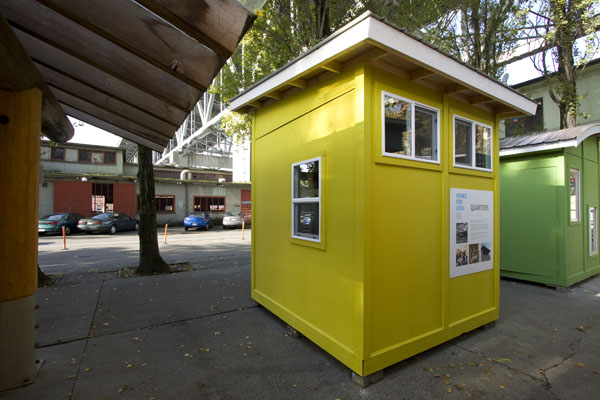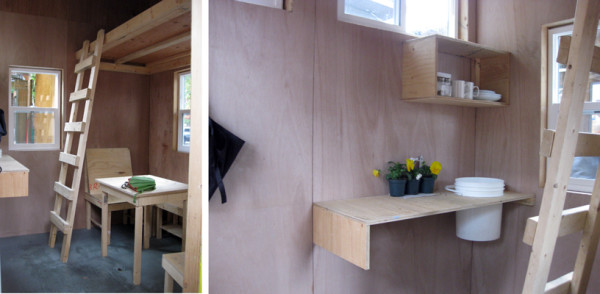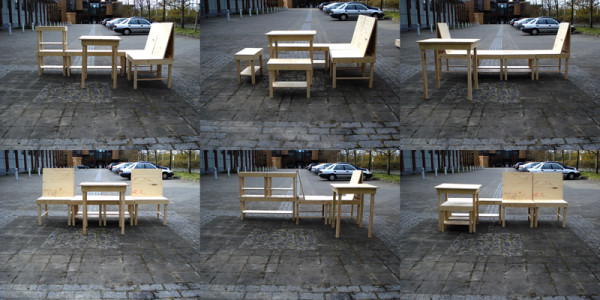Bowen Island seems to be an attraction for tiny houses. It’s home to the Eco-Shed by James Glave and is now home to the Quarters house by industrial designer Amanda Huynh in collaboration with Anna Gukov, Lydia Cambron and Emilie Madill. Following nearly a semester of intense research in materials, compact housing and the homelessness epidemic in Vancouver, a full-scale, timber-framed unit was built to house 1-2 residents in need of a simple shelter.
The 8 foot by 8 foot structure has a built-in sleeping loft, a readily available 5-gallon bucket wash basin, a City of Vancouver rain water barrel and modular furniture, which could be easily configured to create a second sleeping space. Because the individual unit does not provide running water or electricity to reduce cost, it would function best in a community of such dwellings with central kitchen/washroom facilities.
This project is intended to open up a dialogue about a variety of ways in which homelessness in Vancouver could be addressed. Quarters was initially exhibited in Vancouver and Granville Island is is now currently situated on Bowen Island, British Columbia with three others like it.
Photos from Amanda Huynh and Anna Gukov
By Christina Nellemann for the [Tiny House Blog]





Nice post but I can’t claim any credit for the lovely Eco-Shed, that’s James’s marvellous build.
Sorry about that Alex! Of course, the Eco-Shed is designed and built by James Glave. Forgive me James. 🙂
Marvelous design and idea. I watched a show a while back that talked about the costs of homeslessness and it was staggering when you looked at the health care and other costs that the homeless racked up in a year, just a HUGE amount of tax payer money and community resources. I think if communities would commit to creating small clusters of these types of buildings in say, abandoned lots, or space that was not being utilized, a lot of suffering could be saved, as well, as giving folks a hand up. I realize that many of the homeless are suffering from other medical issues and such, and may not readily accept or appreciate these shelters, but many would. It would be awesome if little houses could help to reduce some of the difficulties of these large cities and their homeless issues.
This is awesome! My job only provides housing for part of the year so I am essentially homeless from May until August. I would love to live in something like this 🙂
Nice idea, but I’m looking out my window and wondering if there is any way to provide any heat in there without risking suffocation. No electricity, so what would keep ice from forming on your nose in the winter? But still, it’s MUCH better than sleeping under a bridge!
What good are these without electricity/water/heat, toilet,and food, just to name a few of the things necessary for survival? It is so easy for the fortunate to speak for those in destitute situations as if they have accomplished some “God like” blessing. I think this is a ridiculous sham….
While I always try to remain positive while posting, I tend to agree with deborah here. These may look OK now and, as an alternative to a bridge or even some shelters, this may be minimally better for a night or two, but what would a encampment of these become after a week or two? Not to be too indiscreet, but those buckets look like a cholera epidemic waiting to happen!
Isn’t it cold in Vancouver, too? The heat in my 350 square foot apartment barely kept up with the five degree Fahrenheit temps last night; I can’t imagine living in one of these north of, say, Texas.
The article notes that these would function best in a community with central facilities..
Food service, toilets/showers, water supply, etc can be centralized.
With enough insulation, a human body, or two can heat the space to a livable temperature, although a 60w bulb wouldn’t hurt.
I would use a 2.5 gallon bucket, or dishpan, instead of the 5 gallon bucket, unless you are washing clothes. The 5 gallon bucket is too deep for normal use.
How is it humane to provide shelter with no way to heat it? If this were in Miami then, okay. But no heat in Canada? And no toilet? Just…no. I agree with deborah, it’s a sham. Homeless people are still people and deserve to have the basics of civilized living.
It seems a lot of effort was made ‘to open up a dialogue’ without actually bothering to address real needs.
To Kay & Deborah: I would be totally willing to live someplace without a toilet if somebody were willing to give me free shelter. You realize that modern toilets and indoor plumbing have only existed for a few hundred years max? And humanity survived just fine up until that time; in addition, it is clearly stated in the article that these would best be used in an area with centralized facilities. Just because this doesn’t meet YOUR standards doesn’t mean that the ideas have no merit.
Respectfully, I need to point out that humanity did not survive just fine up until the invention of modern toilets. Even a brief review of public health history yields an understanding of the disease and discomfort that ran rampant before modern plumbing and sewage treatment systems came into being. I fully support the tiny house movement by living in a space smaller than most people’s garages and maintaining a low-consumption lifestyle in general, but the ‘toilet optional’ beliefs of some good folks in the movement… I just can’t see that as a valid component of otherwise healthy and inspirational living.
It’s a moot point in this case. The articlee states that these units would be clustered around centralized kitchen and bathroom facilities. So, it’d be perfectly sanitary.
I think these units are a terrific idea, though I would add a bit of insulation and equip each with solar-powered lighting, such as a $20 solar desk lamp from Ikea.
Some insulation would be nice, but these units would be liveable since temperatures in Vancouver rarely dip below freezing.
I love the eco-shed that you linked to. I also love that when I click on your link to their site (http://www.eco-shed.ca/), it turns out to be a site about coupon codes for Fleshlight male sex toys. Jackpot! Thanks eco-shed.
Josh, that’s unfortunate. It looks like the Eco-Shed site was hacked or they let it lapse.
I wrote several friends last week about shrinking down my requirements to 8′ by 8′. I’ve lived in community (shared housing) a large portion of my life and the idea of having a place of solitude for study and contemplation (think christian mystic tradition)not removed from sanitation, but independent from 24 hour community life would be great. My thought would be to incorporate in scale Passivhaus concepts.
I think that the people who have lived on the streets and the people who have not have quite a different take on things and it’s glaringly and insultingly obvious throughout this discussion. Especially those above who are discussing this as if homeless people wouldn’t come here to read the blog.
Until you’ve been a child/woman/non-alpha male, alone, on the streets & sleeping on cardboard scraps being pelted by freezing rain while all around you are predators- you’d not turn your nose up so fast and judgmentally at 4 walls, a roof & a modicum of safety -being able to lock yourself in and all. And a soft pad to lay upon?
Though thoughtful – I would certainly be able to manage going back and forth washing myself using a 5 gallon and then having it on hand to wash my clothing with at others times. Though I’d much prefer a wetbath closeted off in a corner because centralized locations haven’t proven to be safe either. Talking about a camp- not a commune/community, etc.
No, it’s not “the answer” for homelessness but it’s quite a bit of work toward an answer, which usually -not always, but: you don’t get a scrap of effort from all the naysayers. More often than not they tear apart a ‘good start’ instead of adding into; I recognize many did add into here, but I wonder where Corby thinks homeless people defecate currently & do you find that meets your standards? I’d ask deborah: do all ideas jump from the page fully formed and perfect/ready to go or do we look at the efforts made by those who certainly didn’t need to bother and just tear them apart instead of adding positive commentary? Such as- I’d really desire to have all the windows up on high as that would help with warmth at times but especially privacy.
As Nick and B. said – they’d be happy to be able to have a “home” such as this, and like all people- it is our natural instinct to add onto, make better & improve. Myself, I am 100% prepared to have a home-made composting toilet (which many people use right now) and am willing to exert what steps it takes daily to keep this a sanitary option. Again: windows high & I don’t care if no one likes it because frankly as heck I’ve not had visitors for years in the last few places I’ve been lucky enough to squat in and I neither expect nor desire them after so long.
To confuse “Small House Living efforts” with a more desperate and narrow aim of “Housing the Homeless” is a profound and tragic mis-communication and a hopeless dead end discussion. Think of what most of you had and will have for Holiday dinner, and then think of what they will serve at the soup kitchen/church, etc. In essence – straight analogy.
I feel that especially here, of all places- we should not hear a chorus of no, not good enough -cruel- dismiss this; Rather – ok, let’s roll up our sleeves and see what ideas -what design alterations can be done to get this idea just a bit better than it is now.
But this sort of response came as quite a shock.
Yeah LB!
Your comment is well timed and placed.
I think I would agree with you on all counts. I was thinking the same things before I read your comment. Everyone is so concerned with the fact that they could never see these working for the homeless, but they aren’t thinking that the homeless have and are living in encampments now where they do not have running water or electricity now. And they are doing this in the cold climate here in Canada. But with four walls and out of the cold wind, and out of the elements and off the pavement, I think that a good deal of them would appreciate these well thought out little “homes”, as some of the homeless are only temporarily homeless, working towards reemployment. I am pretty sure that shelters are often full during the cold weather and this would provide safe, secure living arrangements for those that can’t get a bed.
I have never had to live on the streets, but for me I would take an unheated, no electricity or running water box over a cardboard box any day!!!
Thank goodness for open minded people that are working toward helping others!
Well said, LB… Though we must take into account many newer people here have come from the more recent, and in my eyes bastardized, view of tiny houses… from ‘design’, flavor of the month sort of sites, etc.
This is a beautiful example of housing meant to fill a specific need, meant for nothing but to ease some other human’s way through a hard life. Those who complain about the size of the sink or the lack of a toilet are still trying to get their head around 2000 sq. ft. not being necessary to live comfortably… Eventually if they remain on this site (and others like it) they will learn to think more sustainably. Not to mention, hopefully more compationately.
Make that ‘compassionately’. I’ve not had nearly enough coffee to spell yet this morning…
Wow! LB, et all… I didn’t think critical and respectful comments would generate such judgment. Open mindedness seems to be narrowly defined sometimes.
Me again… (I’ve not had enough coffee myself this morning!) Hopefully my responses aren’t viewed as too snarky. I just think that well intentioned people, even if they disagree, should not refer to one another as narrow minded. It’s kindof insulting. But, we’ll carry on…
By the way, if anyone wants to join me at Saint Ben’s Meal Program in Milwaukee tonight, I’ll be there spending a couple hours with some other good people who more than meet my standards.
I agree with LB. If I can’t solve all of the homeless person’s problems should I not offer what I do have? Is not something better than nothing?
I was pretty fascinated by these little inexpensive facilities. Of course the article did mention that it would be best if they were clustered together with shared facilities in common.
Corby, I’m sorry, but I didn’t see a lot of respect in some of those comments. Wish I had. Even looked for it.
So, the question I pose is, “Do you have a better solution to offer? And the biggest question of all, how do we get the building departments, cities, and counties to let us do what we can? As of yet they have over regulationed us to the point that we cannot reach out and help those who most need it.
We live in a tiny community (less than 1,000 population – Washington State), yet even we have a homeless population. Years ago I attempted to get permits to start a “soup kitchen” in the church kitchen. The requirements were staggering and our poor church did not have the funds available to make such massive changes. A ministry I spoke with in California had the same types of problems, though less rigid. Until those in authority become a little more realistic we’ve got our hands tied.
We have an 8′ long x 8′ wide x 14′ high site built micro home. It may be seen on this blog site. It has a full sleeping loft with a 4′ ceiling, space gaining gambrel roof design. There is room in the loft to sit in a chair and even have a composting toilet that we built ourselves, and still sleep two people The unit is fully insulated and can be heated with a standard 1500 watt electric cube heater if necessary. There are also tiny wood stoves available on web sites like Harbor Freight. There is room on the first floor for a 30″ shower stall if you want it, a galley, with an under the counter refrigerator, a two burner gas or electric stove, And a place for two people to sit and relax out of the cold. There is a need for units like these and they can easily be heated. Clusters of these around central facilities are a good idea especially if electric power is available to provide heat and basic amenities. We built our unit as an experiment for a future business mass producing tiny homes and we learned a lot. It is also a test bed for our solar energy product research. I was attracted to the 8′ x 8′ size by the Cube from Germany that has been seen all over the Internet for several years now. It should have a sleeping loft. Based upon what I have learned up to now, I would go with and 12′ long x 8′ wide x 14′ high Gambrel roof with a full sleeping loft.
It would be prefab, and erected on site.
The additional 4′ in length allows a composting toilet and shower on the first floor. There are so many possibilities to pursue. People who are interested should look at the interior layouts of camping trailers. The combination toilet/shower units also found in boats are a great way to go if you have the sewerage facilities. I think that the differences of opinion in the long run are healthy, and will promote change for the better in the emerging field of micro housing. This country started out with many micro homes 300 years ago, and for good reasons. Somewhere we lost site of all that, but the upcoming energy problems and increasing homelessness has started people to thinking in the micro living direction again. There are still many social, economic, and engineering problems to solve regarding micro home living, but we are slowly making progress.
We all have to keep digging at the problems to find the best solutions for everyone.
I personally think these little shacks are great- simple, good-looking, and could be a decent alternative for the homeless. Heating-wise, as others have mentioned, you would be surprised at how quickly a human body can help heat up a small space- or (also mentioned) you could supplement with a 100 watt lightbulb (which give off a good deal of heat), a plug-in, circulatory oil-radiator, or a simple $90 tent-woodstove (although there are fire/safety risks the consider). Anyway, the point being, I don’t see this as so much of a hurdle, and certainly no “sham”. Its not perfect, or without flaws, but it seems a step in the right direction.
Also, it reminds me of Lester Walker’s 8′ by 8′ cabin in his “tiny, tiny houses’ book- one of my favorites. A pre-fabbed structure….
-Deek
Relaxshacks.com
Cube House? I agree… and with the addition of interchangable panels like his, the possibilities are endless.
I’d like to see another article come from this please.
Great sheds, what is the biggest one that they produce?